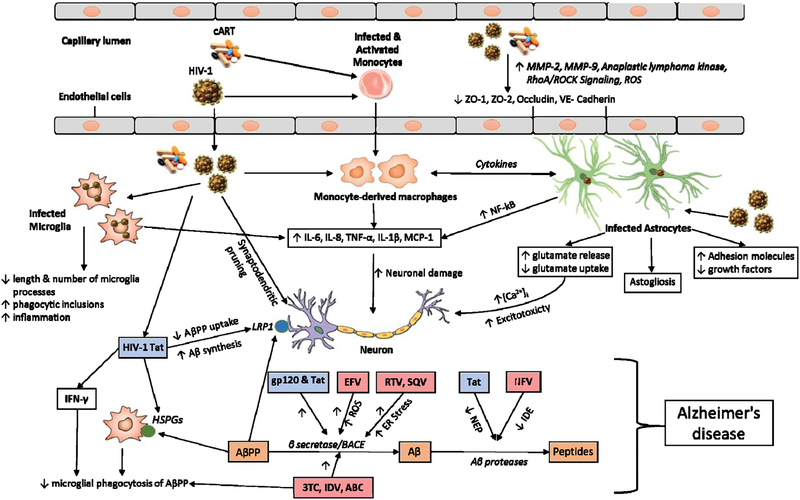Fig. 1.
Schematic overview of HIV-1 effects in CNS. The figure illustrates the mechanisms by which HIV-1, HIV-1 proteins, and cART mediate neurotoxicity; act on endothelial cells to decrease the expression of tight junction proteins; act on microglia to promote the release of various inflammatory factors and increasing phagocytic inclusions; act on monocyte derived macrophages and astrocytes to promote the release of various cytokines that act on neurons directly. HIV-1 infected astrocytes also promote neurotoxicity by decreasing the production of growth factors and altering the glutamate homeostasis. HIV-1 viral proteins (HIV-1 Tat and gp120) and cART promote the formation of Aβ by decreasing AβPP uptake or increasing the activity of BACE or decreasing the activity of NEP and IDE. HIV-1 viral proteins are indicated in blue boxes and various antiretroviral drugs are indicated in light pink boxes. Also included are cART, combination antiretroviral therapy; MMP, matrix metalloproteinase; ROS, reactive oxygen species; ZO, zona occludens; RhoA, Ras homolog gene family, member A; ROCK, Rho-associated protein kinase; IL, interleukin; TNF, tumor necrosis factor; MCP-1, monocyte chemotactic protein 1; AβPP, amyloid-β protein precursor; LRP1, low density lipoprotein receptor-related protein 1; Aβ, amyloid-β; IFN, interferon; HSPGs, heparan sulfate proteoglycans; BACE, beta-site amyloid precursor protein cleaving enzyme; ER, endoplasmic reticulum; EFV, Efavirenz; RTV, Ritonavir; SQV, Saquinavir; 3TC, Lamivudine; IDV, Indinavir; ABC, Abacavir; NFV, Nelfinavir; NEP, Neprilysin; IDE, Insulin degrading enzyme.

